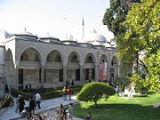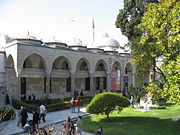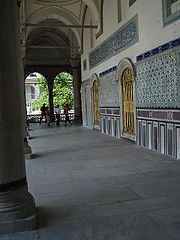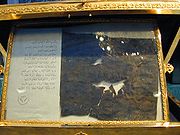
The Sacred Trusts
Encyclopedia



Islam
Islam . The most common are and . : Arabic pronunciation varies regionally. The first vowel ranges from ~~. The second vowel ranges from ~~~...
ic Sacred Relics , also known as the Holy Relics, consist of religious pieces sent to the Ottoman Sultans between the 16th century to the late 19th century.
With the conquest of the Arabic world by Sultan Selim I
Selim I
Selim I, Yavuz Sultân Selim Khan, Hâdim-ül Haramain-ish Sharifain , nicknamed Yavuz "the Stern" or "the Steadfast", but often rendered in English as "the Grim" , was the Sultan of the Ottoman Empire from 1512 to...
(1517), the Caliph
Caliph
The Caliph is the head of state in a Caliphate, and the title for the ruler of the Islamic Ummah, an Islamic community ruled by the Shari'ah. It is a transcribed version of the Arabic word which means "successor" or "representative"...
ate passed from the vanquished Abbasid
Abbasid
The Abbasid Caliphate or, more simply, the Abbasids , was the third of the Islamic caliphates. It was ruled by the Abbasid dynasty of caliphs, who built their capital in Baghdad after overthrowing the Umayyad caliphate from all but the al-Andalus region....
s to the Ottoman sultans. The Islamic prophet Muhammad
Muhammad
Muhammad |ligature]] at U+FDF4 ;Arabic pronunciation varies regionally; the first vowel ranges from ~~; the second and the last vowel: ~~~. There are dialects which have no stress. In Egypt, it is pronounced not in religious contexts...
’s mantle, which was kept by the last Abbasid Caliph Mutawakkil III, was given to Selim I.
The various relics of Muhammad, his followers, and other items purportedly associated with Muhammad were brought to Topkapı Palace
Topkapi Palace
The Topkapı Palace is a large palace in Istanbul, Turkey, that was the primary residence of the Ottoman Sultans for approximately 400 years of their 624-year reign....
in Istanbul
Istanbul
Istanbul , historically known as Byzantium and Constantinople , is the largest city of Turkey. Istanbul metropolitan province had 13.26 million people living in it as of December, 2010, which is 18% of Turkey's population and the 3rd largest metropolitan area in Europe after London and...
, where they remain to this day.
The relics are housed in the former private chambers of the sultan, the Privy Chambers, which are located in the Third Courtyard of the palace.
- The Destimal Chamber is the room in which AbrahamAbrahamAbraham , whose birth name was Abram, is the eponym of the Abrahamic religions, among which are Judaism, Christianity and Islam...
’s Pot, Joseph’s Turban, MosesMosesMoses was, according to the Hebrew Bible and Qur'an, a religious leader, lawgiver and prophet, to whom the authorship of the Torah is traditionally attributed...
’s Staff, DavidDavidDavid was the second king of the united Kingdom of Israel according to the Hebrew Bible and, according to the Gospels of Matthew and Luke, an ancestor of Jesus Christ through both Saint Joseph and Mary...
’s Sword, scrolls belonging to John, and Muhammad’s footprint are on display.
- The Şadırvanlı Sofa is the room where the keys to the KaabaKaabaThe Kaaba is a cuboid-shaped building in Mecca, Saudi Arabia, and is the most sacred site in Islam. The Qur'an states that the Kaaba was constructed by Abraham, or Ibraheem, in Arabic, and his son Ishmael, or Ismaeel, as said in Arabic, after he had settled in Arabia. The building has a mosque...
, the gutters of the Kaaba, the casing of the Black Stone (Hacerü’l-Esved), the Door of Repentance, and the swords of Muhammad's companions are on display.
- The Audience Chamber, also known as the House of Petitions (Arzhane) houses a piece from the tooth of Muhammad (Dendan-ı Saadet), Hair from the Beard of Muhammad (Sakal-ı Şerif), the Seal of Muhammad (Mühr-ı Saadet), an autographed Letter of Muhammad (Name-ı Saadet), and his swords and bow in their exclusive reliquary made by Ottoman goldsmiths. These are known as the Sacred Trusts (mukkades emanetler). The Koran is recited continuously by a muftiMuftiA mufti is a Sunni Islamic scholar who is an interpreter or expounder of Islamic law . In religious administrative terms, a mufti is roughly equivalent to a deacon to a Sunni population...
in this chamber.
- The Chamber of the Blessed Mantle houses the latticed silver canopy under which the Blessed Mantle and the Holy Banner of Muhammad are kept in their golden chests.
Blessed Mantle

Traditionally the mantle was visited by the sultan, his family, and the court during a traditional ceremony on the fifteenth day of Ramadan each year. During the ceremony the mantle was kissed. This was not done directly, but a piece of muslin
Muslin
Muslin |sewing patterns]], such as for clothing, curtains, or upholstery. Because air moves easily through muslin, muslin clothing is suitable for hot, dry climates.- Etymology and history :...
was placed over the vestment. This decorated kerchief, called the Noble Kerchief (destimal-ı şerif), was provided to each person by the Agha of the Muslin (Tülbent Ağası).
The mantle was kept in a golden box, to which only the sultan had the keys. The box was opened while he intoned the besmele. The mantle was actually wrapped in a number of square pieces of cloth called bohças. In it was another small golden box in which forty bohças were wrapped around the mantle itself. The number forty was considered especially auspicious.
The Agha of the Muslin placed the first kerchief on the mantle and the sultan kissed it, followed by the imperial princes, viziers, officials, male attendants, and eunuchs. This was done while Koranic chants filled the chamber.
Then followed the women, who were led by the Queen Mother, followed by the chief consorts, concubines, and daughters of the sultan, as well as the wives of all officials present and female attendants. Princess Imperial Ayşe Osmanoğlu, daughter of Sultan Abdul Hamid II
Abdul Hamid II
His Imperial Majesty, The Sultan Abdülhamid II, Emperor of the Ottomans, Caliph of the Faithful was the 34th sultan of the Ottoman Empire...
, gave a rare eyewitness account in her book “Babam Abdülhamit” (My Father, Abdülhamit), Istanbul, 1960. This passage by Ayşe Sultan provides an intimate glimpse of Abdülhamit II and her life as his daughter:
A button of the mantle was dipped in rose water. Drops of the rose water were poured into pitchers which in turn were given to important people. This water was called the Water of the Blessed Mantle (Hırka-ı Saadet Suyu) and was purported to have miraculous qualities. After the ceremony, the sultan had the mantle packed back into its forty bohças, the small golden box, the other bohças and then into the large golden box which itself was placed under the silver latticed canopy until next year.
Holy Banner
The second most important relic is the Holy Banner, also known as the Sacred Standard of Muhammad (Sancağ-ı Şerif, literally translates as the Noble Banner). It is said to be the banner of Muhammad himself or at least to originate from his era. The origins of the Ottomans acquisition of the relic is disputed. The banner was first used in a battle against the Austrian HabsburgHabsburg
The House of Habsburg , also found as Hapsburg, and also known as House of Austria is one of the most important royal houses of Europe and is best known for being an origin of all of the formally elected Holy Roman Emperors between 1438 and 1740, as well as rulers of the Austrian Empire and...
s in 1593 and again for a war in Hungary in 1594. The banner was in Topkapı by 1595. After Mehmed III took the banner and won the Siege of Eger
Siege of Eger
The Siege of Eger occurred during the 16th century Ottoman Wars in Europe. It was a major Hungarian victory after a series of crushing defeats at the hands of Ottoman forces and checked the Ottoman expansion into both Central Europe and Eastern Europe....
in 1596, the banner became a victory symbol for the Ottoman forces.
The banner was occasionally carried into battles to encourage troops and ensure victory. The banner would be taken out of its box by the sultan and affixed to a staff. He would carry it from the Chamber of the Holy Relics to the Throne Room while officials called out “Allah Akbar!” (God is great). After this, the banner was carried from the Throne Room to the Gate of Felicity and placed there. The grand vizier would receive the banner from the sultan in a ceremony in the Throne Room. While the grand vizier and the şeyhülislâm stood in attendance, the sultan would kiss the Holy Banner and entrust it to his grand vizier with the words: “I entrust the Sacred Standard to you and you to God. May He be your helper!” After a battle, the banner would be returned the same way with the sultan carrying it back to the chamber and putting it into its box, while Koranic chants were read aloud and incense burned.
The banner was also taken out when mutinies by Janissaries erupted in 1651 and for the last time in 1826.
Muhammad's Bowl
1400 year old bowl that was used by Muhammad after his death was kept by his daughter FatimahFatimah
Fatimah was a daughter of the Islamic prophet Muhammad from his first wife Khadijah bint Khuwaylid. She is regarded by Muslims as an exemplar for men and women. She remained at her father's side through the difficulties suffered by him at the hands of the Quraysh of Mecca...
and her husband Ali
Ali
' |Ramaḍān]], 40 AH; approximately October 23, 598 or 600 or March 17, 599 – January 27, 661).His father's name was Abu Talib. Ali was also the cousin and son-in-law of the Islamic prophet Muhammad, and ruled over the Islamic Caliphate from 656 to 661, and was the first male convert to Islam...
, the fourth Caliph
Caliph
The Caliph is the head of state in a Caliphate, and the title for the ruler of the Islamic Ummah, an Islamic community ruled by the Shari'ah. It is a transcribed version of the Arabic word which means "successor" or "representative"...
and Muhammad's cousin. After their death, the bowl was kept by their children Hasan and Husein. The bowl was passed from generation to generation by descendants of Muhammad until it finally reached Britain. On 21 Sept 2011 the bowl was delivered to Chechnya
Chechnya
The Chechen Republic , commonly referred to as Chechnya , also spelled Chechnia or Chechenia, sometimes referred to as Ichkeria , is a federal subject of Russia . It is located in the southeastern part of Europe in the Northern Caucasus mountains. The capital of the republic is the city of Grozny...
and now is kept in "Heart of Chechnya" Mosque named after Ahmad Haji Kadyrov in Grozny
Grozny
Grozny is the capital city of the Chechen Republic, Russia. The city lies on the Sunzha River. According to the preliminary results of the 2010 Census, the city had a population of 271,596; up from 210,720 recorded in the 2002 Census. but still only about two-thirds of 399,688 recorded in the 1989...
.
Regarding the bowl, Ibn Kathir
Ibn Kathir
Ismail ibn Kathir was a Muslim muhaddith, Faqih, historian, and commentator.-Biography:His full name was Abu Al-Fida, 'Imad Ad-Din, Isma'il bin 'Umar bin Kathir, Al-Qurashi, Al-Busrawi...
, the Islamic scholar and commentator on the Qur'an
Qur'an
The Quran , also transliterated Qur'an, Koran, Alcoran, Qur’ān, Coran, Kuran, and al-Qur’ān, is the central religious text of Islam, which Muslims consider the verbatim word of God . It is regarded widely as the finest piece of literature in the Arabic language...
, writes in his book Wives of the Prophet Muhammad:

